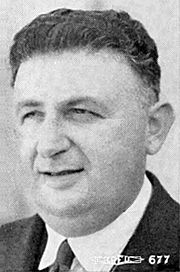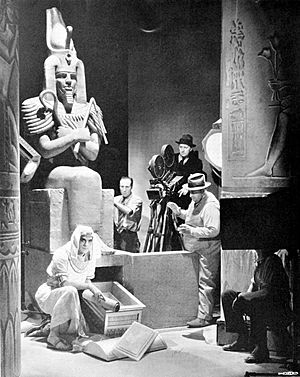Karl Freund facts for kids
Quick facts for kids
Karl Freund
|
|
|---|---|

Karl Freund in 1932
|
|
| Born |
Karl W. Freund
January 16, 1890 Dvůr Králové, Bohemia, Austria-Hungary
|
| Died | May 3, 1969 (aged 79) Santa Monica, California, U.S.
|
| Nationality | German |
| Occupation | Cinematography |
| Years active | 1926–1969 |
| Known for | Pioneer of Entfesselte Kamera |
| Children | Gerda Martel |
Karl W. Freund, A.S.C. (January 16, 1890 – May 3, 1969) was a German Bohemian and American cinematographer and film director. He is best known for photographing Metropolis (1927), Dracula (1931), and television's I Love Lucy (1951–1957). Freund was an innovator in the field of cinematography, often noted for pioneering the unchained camera technique.
Contents
Early life
Karl Freund was born in Dvůr Králové, Bohemia. When he was 11 his family moved to Berlin. His career began in 1905 when, at age 15, he was hired as an apprentice projectionist for Alfred Duskes films. In 1907, he began work at the International Cinematograph and Light Effect Society. Freund was drafted by the Imperial Army to fight in World War I but was released from duty after only three months.
Early film career
Freund began his film career in 1905. He was a newsreel cameraman in 1907 and a year later was working for Sascha-Film in Vienna. In 1911, Freund moved to Belgrade to create a film laboratory for the Brothers Savic. Freund worked as a cinematographer on over 100 films, including the German Expressionist films The Golem (1920) and The Last Laugh (1924). Freund worked with director Fritz Lang on a multiple projects, of which Metropolis (1927) is the best known. Freund co-wrote, and was cinematographer on, Berlin: Symphony of a Metropolis (1927), directed by Walter Ruttmann. Between 1926 and 1929, Freund was the production head at Fox Europa Film.
Freund's only known film as an actor is Carl Theodor Dreyer's Michael (1924) in which he appears as a sycophantic art dealer who saves the tobacco ashes dropped by a famous painter.
Innovation in Cinematography
Early in his career Freund began to experiment with different ways of filming and new aspects of film. In 1914 he worked with Oskar Messter, a pioneering inventor and experimenter with sound film technology.
The Unchained Camera
Karl Freund was a pioneer of the unchained camera. In films such as Der letzte Mann, the unchained camera was a revolution in early film. For the first time, the camera was free of the tripod and could move around the set. Because it was no longer confined to one position, thousands of new shots were possible. Freund was known to wear the camera on his stomach and walk around while it was filming. He would also put the camera on a cart that moved along a track. Several other innovative ways of moving the camera were introduced by Freund, including putting the camera on a crane.
American film and television career
Freund immigrated to the United States in 1929, where he continued to shoot well-remembered films such as Dracula (1931) and Key Largo (1948). His work on Dracula came under a mostly disorganized shoot, with the usually meticulous director Tod Browning leaving cinematographer Freund to take over during much of filming, making Freund something of an uncredited director on the film. He won an Academy Award for Best Cinematography for The Good Earth (1937).

Between 1921 and 1935, Freund directed 10 films, of which the best known are probably his two credited horror films, The Mummy (1932) starring Boris Karloff, and his last film as director, Mad Love (1935) starring Peter Lorre.
Freund worked under contract for MGM and Warner Bros. In 1944 he founded the Photo Research Corporation of Burbank to manufacture TV cameras and exposure meters.
I Love Lucy
At the beginning of the 1950s, he was persuaded by Desi Arnaz at Desilu to be the cinematographer for the television series I Love Lucy from 1951. Critics have credited Freund for the show's lustrous black and white cinematography, but more important, Freund designed the "flat lighting" system for shooting sitcoms that is still in use today. This system covers the set in light, thus eliminating shadows and allowing the use of three moving cameras without having to modify the lighting between shots. While Freund did not invent the three-camera shooting system, he did perfect it for use with film cameras in front of a live audience. The cameras that were used were BNC Mitchell cameras with T-stop calibrated lenses on dollies. The center camera was for wider shots. The other two were positioned 75 to 90 degrees away from center and were primarily used for close-ups.
Despite his extensive experience in film cinematography, Freund said that switching to television was a challenge for him. Because I Love Lucy was filmed in front of a live audience there were restrictions on where the camera could be placed.
Freund and his production team also worked on other sitcoms produced at/through Desilu, such as Our Miss Brooks.
Photo Research Corporation
In 1941, he founded Photo Research Corporation with the intent to develop products to improve the quality of motion picture photography. One early notable product was the Norwood Director direct-reading incident light meter, developed with Donald W. Norwood. After the first model's success, the two parted ways. Photo Research retained rights to produce and improve the model. It was now produced under the Spectra name, with continuing improvement. It was this photometer product and a direct-reading brightness meter that earned Freund two Academy Awards for technical achievement from the Motion Picture Academy of Arts and Sciences.
The brightness meter mentioned above (Model 1415UB) became a popular instrument, appearing in many laboratories' catalogs. That meter accompanied 1950's astronauts on the Project ManHigh balloon missions reaching nearly 100,000 ft altitude. Below is a description of that meter's import by eminent lighting engineer David DiLaura.
"In 1952, Karl Freund of Photo Research Corporation produced a luminance meter that eliminated visual photometry [visual photometery is comparing two light sources visually to determine brightness]. Freund borrowed some of the technology that had been developed by William Baum of the Palomar Observatory to measure star luminance. Compact photomultiplier tubes had been developed that could detect very small amounts of light. At the same time, miniature, high sensitivity, low power electrometer amplifier vacuum tubes had become available that could amplify the small signal currents that the photo tubes generated. Freund used this technology as the light detection system in his luminance meter."
Both Spectra and Photo Research are still producing fine measurement equipment. Spectra split off from Photo Research in 1986 as Spectra-Cine Inc. Photo Research currently exists as a subsidiary of Jadak Inc, manufacturing light and color measurement devices. The Photo Research PR-650 spectroradiometer with telescope input and Pritchard viewfinder (viewfinder invented during Freund's time) was for years the standard luminance and color measurement device used in the fields of display manufacture and psychophysiology. Like most laboratory equipment, even the equipment from the 1940s is robust and remains serviceable.
Personal life
In 1937, he visited Germany to bring to the United States his only daughter, Gerda Maria Freund (1916 – 2017), saving her from almost certain death in the concentration camps. His ex-wife, Susette Freund (née Liepmannssohn), remained in Germany, where she died at the Ravensbrück concentration camp in 1942.
Selected filmography
As cinematographer
- The Robber Bride (1916)
- The Queen's Love Letter (1916)
- The Giant's Fist (1917)
- Mountain Air (1917)
- The Princess of Neutralia (1917)
- The Man in the Mirror (1917)
- The Marriage of Luise Rohrbach (1917)
- Countess Kitchenmaid (1918)
- Put to the Test (1918)
- The Victors (1918)
- The Lady, the Devil and the Model (1918)
- The Ringwall Family (1918)
- Precious Stones (1918)
- Agnes Arnau and Her Three Suitors (1918)
- The Blue Lantern (1918)
- Die Arche (1919)
- The Night at Goldenhall (1920)
- Catherine the Great (1920)
- The Golem (1920)
- Der Januskopf (1920)
- The Oath of Peter Hergatz (1921)
- Children of Darkness (1921)
- The Rats (1921)
- The Story of Christine von Herre (1921)
- Lucrezia Borgia (1922)
- Louise de Lavallière (1922)
- The Last Laugh (1924)
- Michael (1924)
- Variety (1925)
- Tartuffe (1926)
- The Mill at Sanssouci (1926)
- Out of the Mist (1927)
- Doña Juana (1927)
- Metropolis (1927)
- Berlin: Symphony of a Metropolis (1927)
- A Knight in London (1929)
- Fräulein Else (1929)
- Sleeping Partners (1930)
- Bad Sister (1931)
- Dracula (1931)
- Back Street (1932)
- The Kiss Before the Mirror (1933)
- Camille (1936)
- The Good Earth (1937)
- Parnell (1937)
- Conquest (1937)
- Letter of Introduction (1938)
- Man-Proof (1938)
- Tail Spin (1939)
- Golden Boy (1939)
- Rose of Washington Square (1939)
- Balalaika (1939)
- Pride and Prejudice (1940)
- Green Hell (1940)
- Blossoms in the Dust (1941)
- Tortilla Flat (1942)
- Cry "Havoc" (1943)
- A Guy Named Joe (1943)
- Du Barry Was a Lady (1943)
- The Seventh Cross (1944)
- Without Love (1945)
- The Thin Man Goes Home (1945)
- A Letter for Evie (1946)
- Undercurrent (1946)
- Two Smart People (1946)
- That Hagen Girl (1947)
- This Time for Keeps (1947)
- Key Largo (1948)
- South of St. Louis (1949)
- Montana (1950)
- Bright Leaf (1950)
As director
- The Sensational Trial (1923)
- The Mummy (1932)
- Moonlight and Pretzels (1933)
- Madame Spy (1934)
- The Countess of Monte Cristo (1934)
- Uncertain Lady (1934)
- I Give My Love (1934)
- Gift of Gab (1934)
- Mad Love (1935)
As producer
- Madame Wants No Children (1926)
See also
- List of German-speaking Academy Award winners and nominees

